A Study on the Negative Impacts of Urban Tourism in Cambridge City
VerifiedAdded on 2020/01/07
|22
|5469
|290
Report
AI Summary
This report investigates the negative impacts of urban tourism on Cambridge, UK. It begins with an introduction to urban tourism, defining its characteristics and significance, particularly within the UK context, and highlighting Cambridge's popularity as a tourist destination. A literature review explores the concept of urban tourism, its resources, and the factors influencing its evolution, including changing visitor behaviors and motivations. The review also covers various tourism theories, such as the travel career ladder and push/pull factors. The core of the report focuses on the negative consequences of urban tourism, such as noise and air pollution, overcrowding, and the rising cost of living. It examines how tourism can negatively affect the local society, including educational institutions and the cultural landscape. The report then presents a research methodology, focusing on the research design employed. The analysis will likely present findings related to these negative impacts. The conclusion will summarize the key findings and offer recommendations to mitigate the adverse effects of urban tourism. References and an appendix are included to support the research.
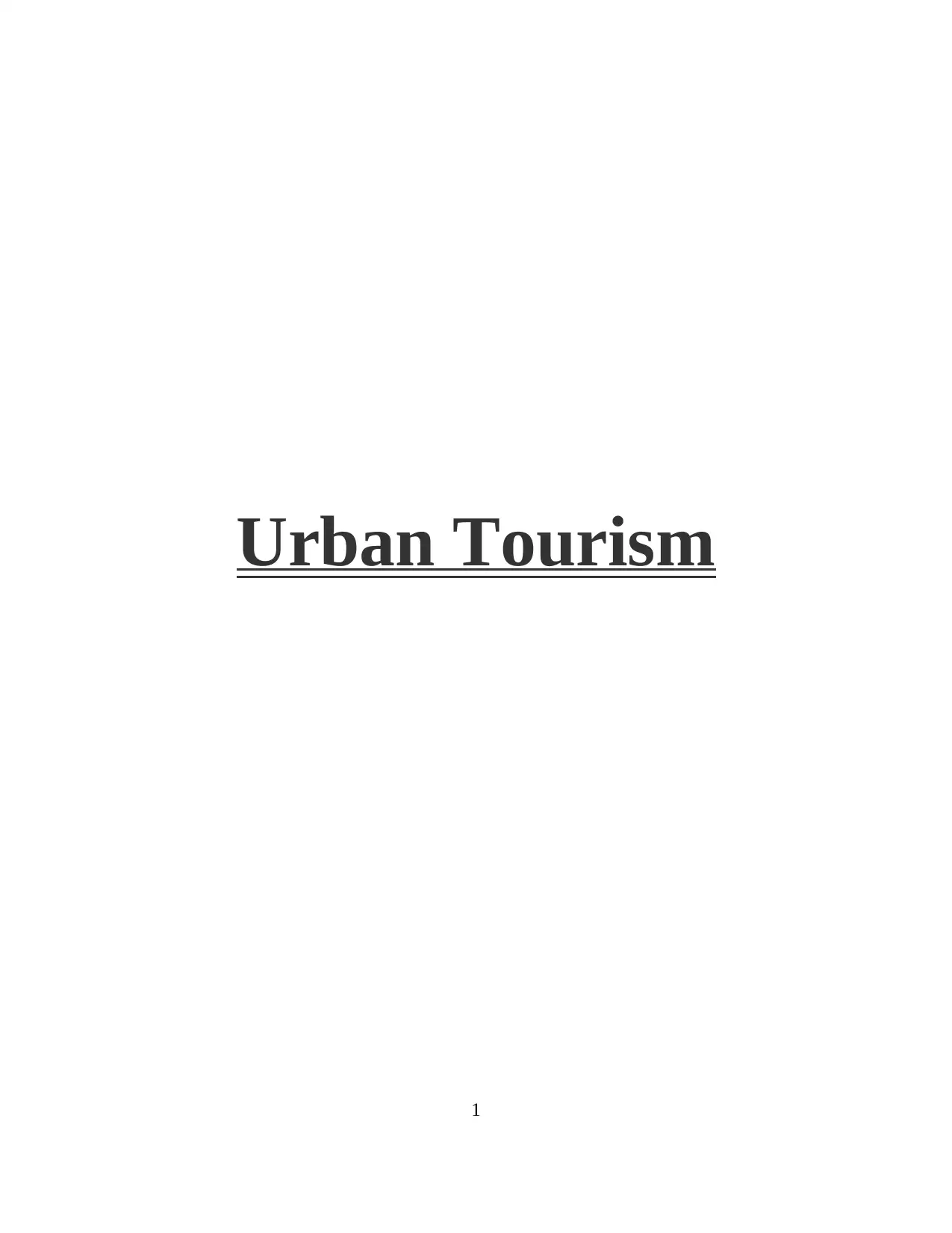
Urban Tourism
1
1
Paraphrase This Document
Need a fresh take? Get an instant paraphrase of this document with our AI Paraphraser
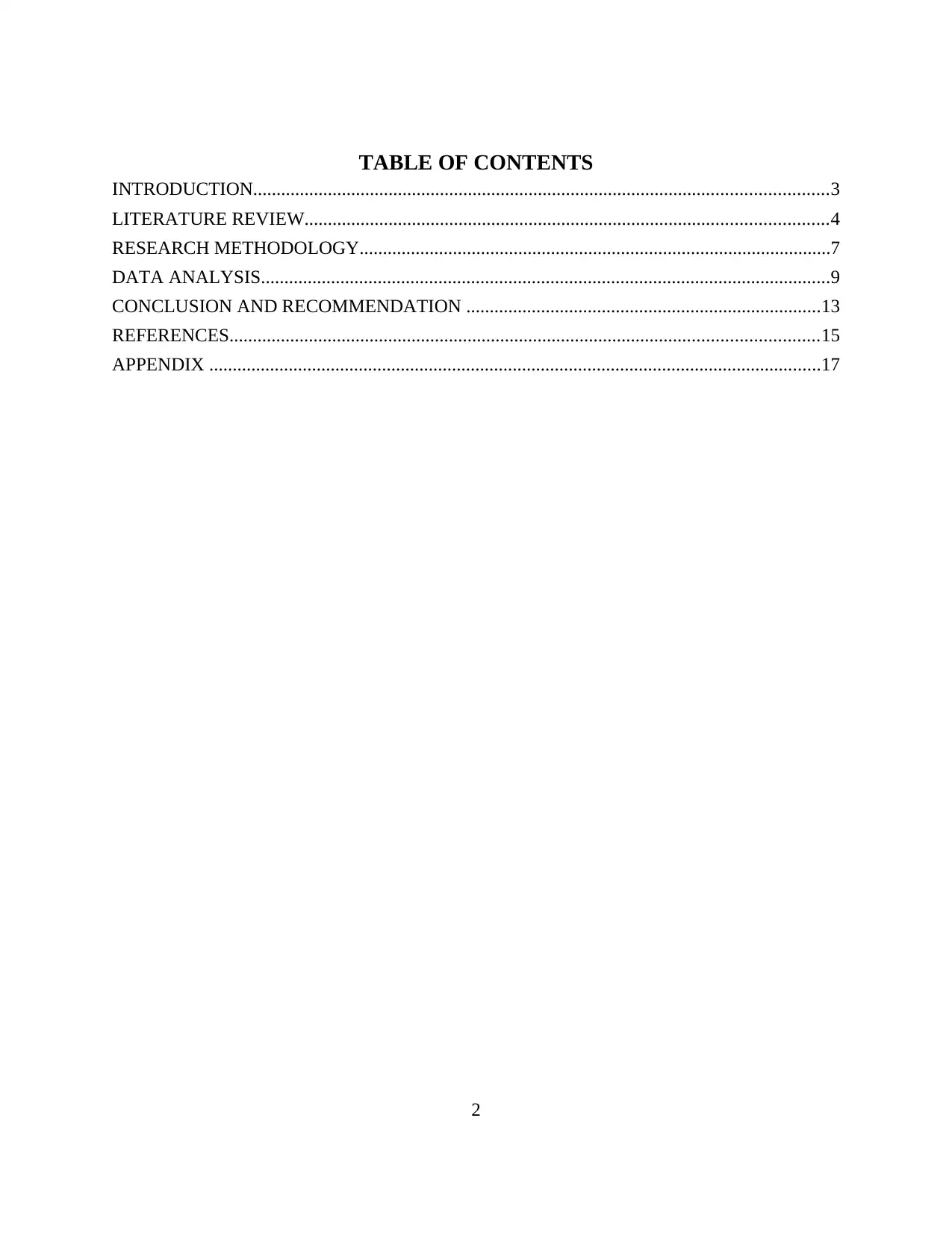
TABLE OF CONTENTS
INTRODUCTION...........................................................................................................................3
LITERATURE REVIEW................................................................................................................4
RESEARCH METHODOLOGY.....................................................................................................7
DATA ANALYSIS..........................................................................................................................9
CONCLUSION AND RECOMMENDATION ............................................................................13
REFERENCES..............................................................................................................................15
APPENDIX ...................................................................................................................................17
2
INTRODUCTION...........................................................................................................................3
LITERATURE REVIEW................................................................................................................4
RESEARCH METHODOLOGY.....................................................................................................7
DATA ANALYSIS..........................................................................................................................9
CONCLUSION AND RECOMMENDATION ............................................................................13
REFERENCES..............................................................................................................................15
APPENDIX ...................................................................................................................................17
2
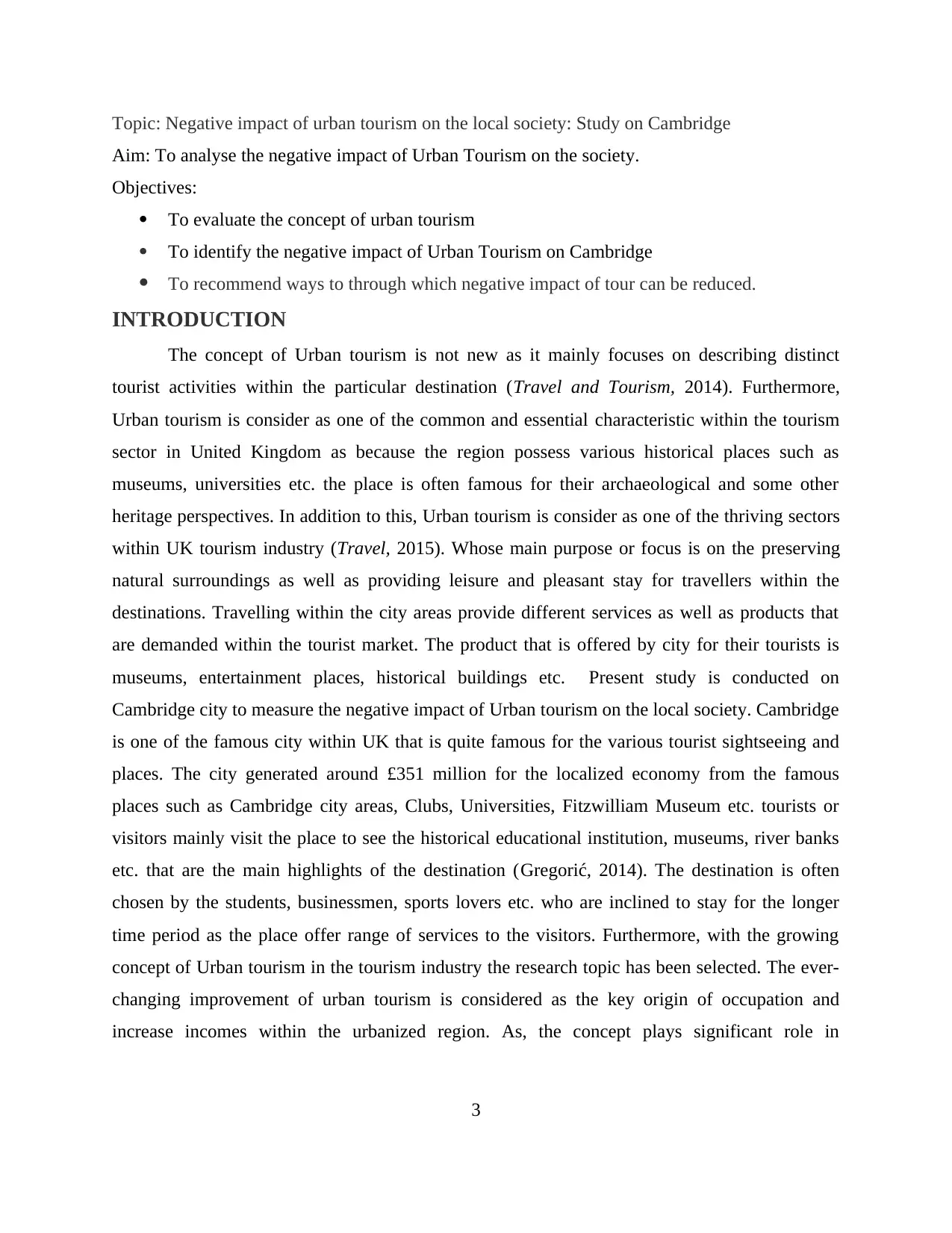
Topic: Negative impact of urban tourism on the local society: Study on Cambridge
Aim: To analyse the negative impact of Urban Tourism on the society.
Objectives:
To evaluate the concept of urban tourism
To identify the negative impact of Urban Tourism on Cambridge
To recommend ways to through which negative impact of tour can be reduced.
INTRODUCTION
The concept of Urban tourism is not new as it mainly focuses on describing distinct
tourist activities within the particular destination (Travel and Tourism, 2014). Furthermore,
Urban tourism is consider as one of the common and essential characteristic within the tourism
sector in United Kingdom as because the region possess various historical places such as
museums, universities etc. the place is often famous for their archaeological and some other
heritage perspectives. In addition to this, Urban tourism is consider as one of the thriving sectors
within UK tourism industry (Travel, 2015). Whose main purpose or focus is on the preserving
natural surroundings as well as providing leisure and pleasant stay for travellers within the
destinations. Travelling within the city areas provide different services as well as products that
are demanded within the tourist market. The product that is offered by city for their tourists is
museums, entertainment places, historical buildings etc. Present study is conducted on
Cambridge city to measure the negative impact of Urban tourism on the local society. Cambridge
is one of the famous city within UK that is quite famous for the various tourist sightseeing and
places. The city generated around £351 million for the localized economy from the famous
places such as Cambridge city areas, Clubs, Universities, Fitzwilliam Museum etc. tourists or
visitors mainly visit the place to see the historical educational institution, museums, river banks
etc. that are the main highlights of the destination (Gregorić, 2014). The destination is often
chosen by the students, businessmen, sports lovers etc. who are inclined to stay for the longer
time period as the place offer range of services to the visitors. Furthermore, with the growing
concept of Urban tourism in the tourism industry the research topic has been selected. The ever-
changing improvement of urban tourism is considered as the key origin of occupation and
increase incomes within the urbanized region. As, the concept plays significant role in
3
Aim: To analyse the negative impact of Urban Tourism on the society.
Objectives:
To evaluate the concept of urban tourism
To identify the negative impact of Urban Tourism on Cambridge
To recommend ways to through which negative impact of tour can be reduced.
INTRODUCTION
The concept of Urban tourism is not new as it mainly focuses on describing distinct
tourist activities within the particular destination (Travel and Tourism, 2014). Furthermore,
Urban tourism is consider as one of the common and essential characteristic within the tourism
sector in United Kingdom as because the region possess various historical places such as
museums, universities etc. the place is often famous for their archaeological and some other
heritage perspectives. In addition to this, Urban tourism is consider as one of the thriving sectors
within UK tourism industry (Travel, 2015). Whose main purpose or focus is on the preserving
natural surroundings as well as providing leisure and pleasant stay for travellers within the
destinations. Travelling within the city areas provide different services as well as products that
are demanded within the tourist market. The product that is offered by city for their tourists is
museums, entertainment places, historical buildings etc. Present study is conducted on
Cambridge city to measure the negative impact of Urban tourism on the local society. Cambridge
is one of the famous city within UK that is quite famous for the various tourist sightseeing and
places. The city generated around £351 million for the localized economy from the famous
places such as Cambridge city areas, Clubs, Universities, Fitzwilliam Museum etc. tourists or
visitors mainly visit the place to see the historical educational institution, museums, river banks
etc. that are the main highlights of the destination (Gregorić, 2014). The destination is often
chosen by the students, businessmen, sports lovers etc. who are inclined to stay for the longer
time period as the place offer range of services to the visitors. Furthermore, with the growing
concept of Urban tourism in the tourism industry the research topic has been selected. The ever-
changing improvement of urban tourism is considered as the key origin of occupation and
increase incomes within the urbanized region. As, the concept plays significant role in
3
⊘ This is a preview!⊘
Do you want full access?
Subscribe today to unlock all pages.

Trusted by 1+ million students worldwide
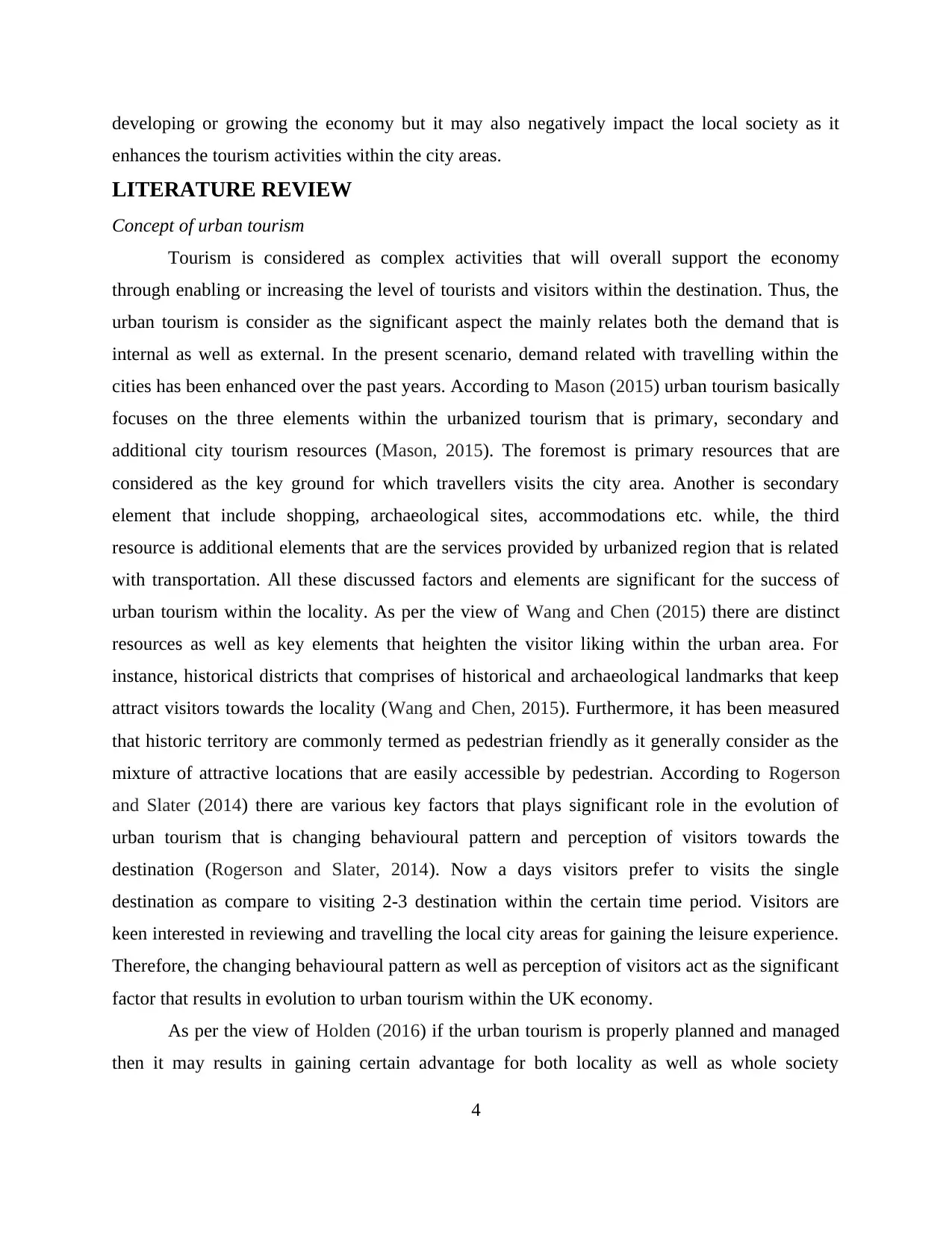
developing or growing the economy but it may also negatively impact the local society as it
enhances the tourism activities within the city areas.
LITERATURE REVIEW
Concept of urban tourism
Tourism is considered as complex activities that will overall support the economy
through enabling or increasing the level of tourists and visitors within the destination. Thus, the
urban tourism is consider as the significant aspect the mainly relates both the demand that is
internal as well as external. In the present scenario, demand related with travelling within the
cities has been enhanced over the past years. According to Mason (2015) urban tourism basically
focuses on the three elements within the urbanized tourism that is primary, secondary and
additional city tourism resources (Mason, 2015). The foremost is primary resources that are
considered as the key ground for which travellers visits the city area. Another is secondary
element that include shopping, archaeological sites, accommodations etc. while, the third
resource is additional elements that are the services provided by urbanized region that is related
with transportation. All these discussed factors and elements are significant for the success of
urban tourism within the locality. As per the view of Wang and Chen (2015) there are distinct
resources as well as key elements that heighten the visitor liking within the urban area. For
instance, historical districts that comprises of historical and archaeological landmarks that keep
attract visitors towards the locality (Wang and Chen, 2015). Furthermore, it has been measured
that historic territory are commonly termed as pedestrian friendly as it generally consider as the
mixture of attractive locations that are easily accessible by pedestrian. According to Rogerson
and Slater (2014) there are various key factors that plays significant role in the evolution of
urban tourism that is changing behavioural pattern and perception of visitors towards the
destination (Rogerson and Slater, 2014). Now a days visitors prefer to visits the single
destination as compare to visiting 2-3 destination within the certain time period. Visitors are
keen interested in reviewing and travelling the local city areas for gaining the leisure experience.
Therefore, the changing behavioural pattern as well as perception of visitors act as the significant
factor that results in evolution to urban tourism within the UK economy.
As per the view of Holden (2016) if the urban tourism is properly planned and managed
then it may results in gaining certain advantage for both locality as well as whole society
4
enhances the tourism activities within the city areas.
LITERATURE REVIEW
Concept of urban tourism
Tourism is considered as complex activities that will overall support the economy
through enabling or increasing the level of tourists and visitors within the destination. Thus, the
urban tourism is consider as the significant aspect the mainly relates both the demand that is
internal as well as external. In the present scenario, demand related with travelling within the
cities has been enhanced over the past years. According to Mason (2015) urban tourism basically
focuses on the three elements within the urbanized tourism that is primary, secondary and
additional city tourism resources (Mason, 2015). The foremost is primary resources that are
considered as the key ground for which travellers visits the city area. Another is secondary
element that include shopping, archaeological sites, accommodations etc. while, the third
resource is additional elements that are the services provided by urbanized region that is related
with transportation. All these discussed factors and elements are significant for the success of
urban tourism within the locality. As per the view of Wang and Chen (2015) there are distinct
resources as well as key elements that heighten the visitor liking within the urban area. For
instance, historical districts that comprises of historical and archaeological landmarks that keep
attract visitors towards the locality (Wang and Chen, 2015). Furthermore, it has been measured
that historic territory are commonly termed as pedestrian friendly as it generally consider as the
mixture of attractive locations that are easily accessible by pedestrian. According to Rogerson
and Slater (2014) there are various key factors that plays significant role in the evolution of
urban tourism that is changing behavioural pattern and perception of visitors towards the
destination (Rogerson and Slater, 2014). Now a days visitors prefer to visits the single
destination as compare to visiting 2-3 destination within the certain time period. Visitors are
keen interested in reviewing and travelling the local city areas for gaining the leisure experience.
Therefore, the changing behavioural pattern as well as perception of visitors act as the significant
factor that results in evolution to urban tourism within the UK economy.
As per the view of Holden (2016) if the urban tourism is properly planned and managed
then it may results in gaining certain advantage for both locality as well as whole society
4
Paraphrase This Document
Need a fresh take? Get an instant paraphrase of this document with our AI Paraphraser
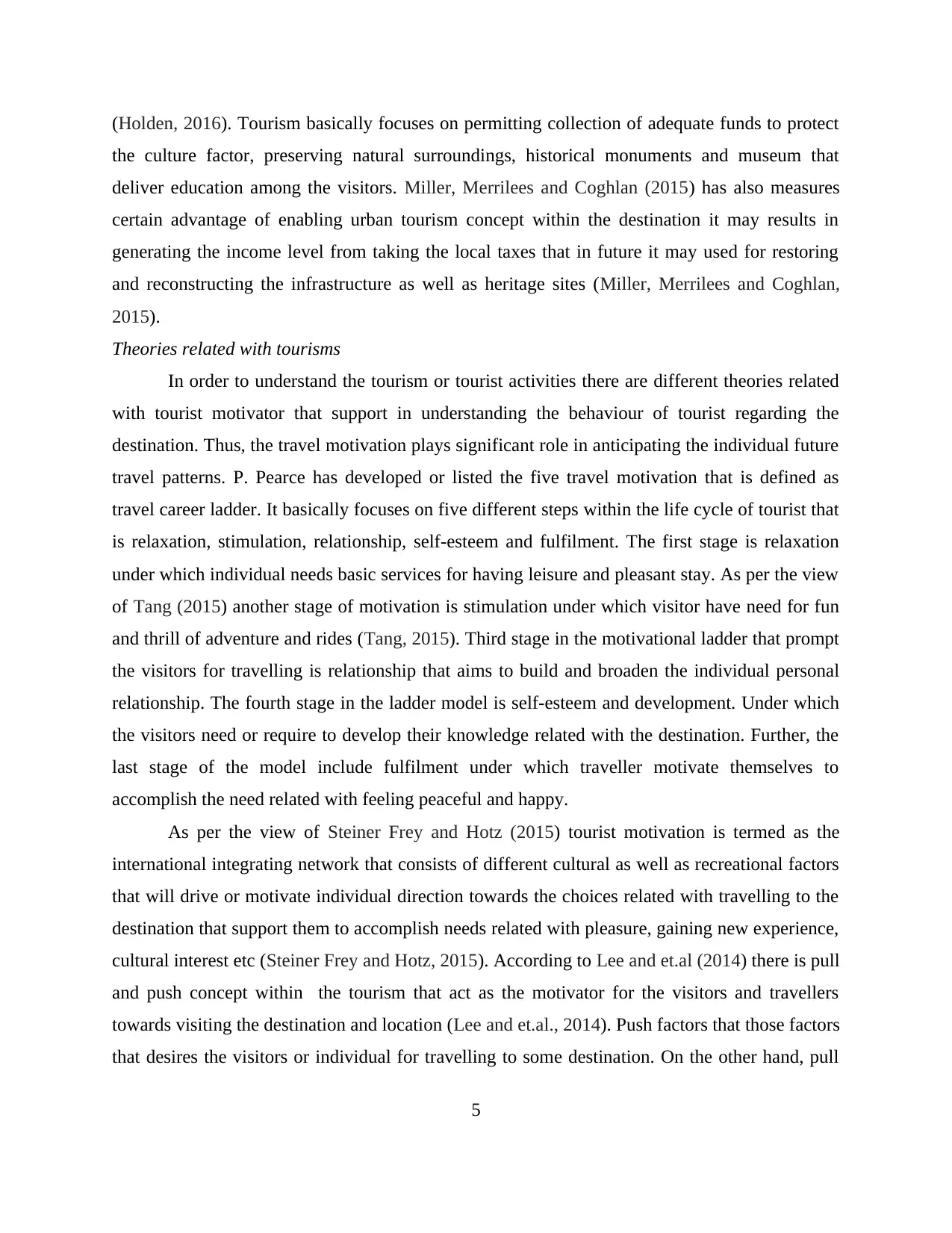
(Holden, 2016). Tourism basically focuses on permitting collection of adequate funds to protect
the culture factor, preserving natural surroundings, historical monuments and museum that
deliver education among the visitors. Miller, Merrilees and Coghlan (2015) has also measures
certain advantage of enabling urban tourism concept within the destination it may results in
generating the income level from taking the local taxes that in future it may used for restoring
and reconstructing the infrastructure as well as heritage sites (Miller, Merrilees and Coghlan,
2015).
Theories related with tourisms
In order to understand the tourism or tourist activities there are different theories related
with tourist motivator that support in understanding the behaviour of tourist regarding the
destination. Thus, the travel motivation plays significant role in anticipating the individual future
travel patterns. P. Pearce has developed or listed the five travel motivation that is defined as
travel career ladder. It basically focuses on five different steps within the life cycle of tourist that
is relaxation, stimulation, relationship, self-esteem and fulfilment. The first stage is relaxation
under which individual needs basic services for having leisure and pleasant stay. As per the view
of Tang (2015) another stage of motivation is stimulation under which visitor have need for fun
and thrill of adventure and rides (Tang, 2015). Third stage in the motivational ladder that prompt
the visitors for travelling is relationship that aims to build and broaden the individual personal
relationship. The fourth stage in the ladder model is self-esteem and development. Under which
the visitors need or require to develop their knowledge related with the destination. Further, the
last stage of the model include fulfilment under which traveller motivate themselves to
accomplish the need related with feeling peaceful and happy.
As per the view of Steiner Frey and Hotz (2015) tourist motivation is termed as the
international integrating network that consists of different cultural as well as recreational factors
that will drive or motivate individual direction towards the choices related with travelling to the
destination that support them to accomplish needs related with pleasure, gaining new experience,
cultural interest etc (Steiner Frey and Hotz, 2015). According to Lee and et.al (2014) there is pull
and push concept within the tourism that act as the motivator for the visitors and travellers
towards visiting the destination and location (Lee and et.al., 2014). Push factors that those factors
that desires the visitors or individual for travelling to some destination. On the other hand, pull
5
the culture factor, preserving natural surroundings, historical monuments and museum that
deliver education among the visitors. Miller, Merrilees and Coghlan (2015) has also measures
certain advantage of enabling urban tourism concept within the destination it may results in
generating the income level from taking the local taxes that in future it may used for restoring
and reconstructing the infrastructure as well as heritage sites (Miller, Merrilees and Coghlan,
2015).
Theories related with tourisms
In order to understand the tourism or tourist activities there are different theories related
with tourist motivator that support in understanding the behaviour of tourist regarding the
destination. Thus, the travel motivation plays significant role in anticipating the individual future
travel patterns. P. Pearce has developed or listed the five travel motivation that is defined as
travel career ladder. It basically focuses on five different steps within the life cycle of tourist that
is relaxation, stimulation, relationship, self-esteem and fulfilment. The first stage is relaxation
under which individual needs basic services for having leisure and pleasant stay. As per the view
of Tang (2015) another stage of motivation is stimulation under which visitor have need for fun
and thrill of adventure and rides (Tang, 2015). Third stage in the motivational ladder that prompt
the visitors for travelling is relationship that aims to build and broaden the individual personal
relationship. The fourth stage in the ladder model is self-esteem and development. Under which
the visitors need or require to develop their knowledge related with the destination. Further, the
last stage of the model include fulfilment under which traveller motivate themselves to
accomplish the need related with feeling peaceful and happy.
As per the view of Steiner Frey and Hotz (2015) tourist motivation is termed as the
international integrating network that consists of different cultural as well as recreational factors
that will drive or motivate individual direction towards the choices related with travelling to the
destination that support them to accomplish needs related with pleasure, gaining new experience,
cultural interest etc (Steiner Frey and Hotz, 2015). According to Lee and et.al (2014) there is pull
and push concept within the tourism that act as the motivator for the visitors and travellers
towards visiting the destination and location (Lee and et.al., 2014). Push factors that those factors
that desires the visitors or individual for travelling to some destination. On the other hand, pull
5
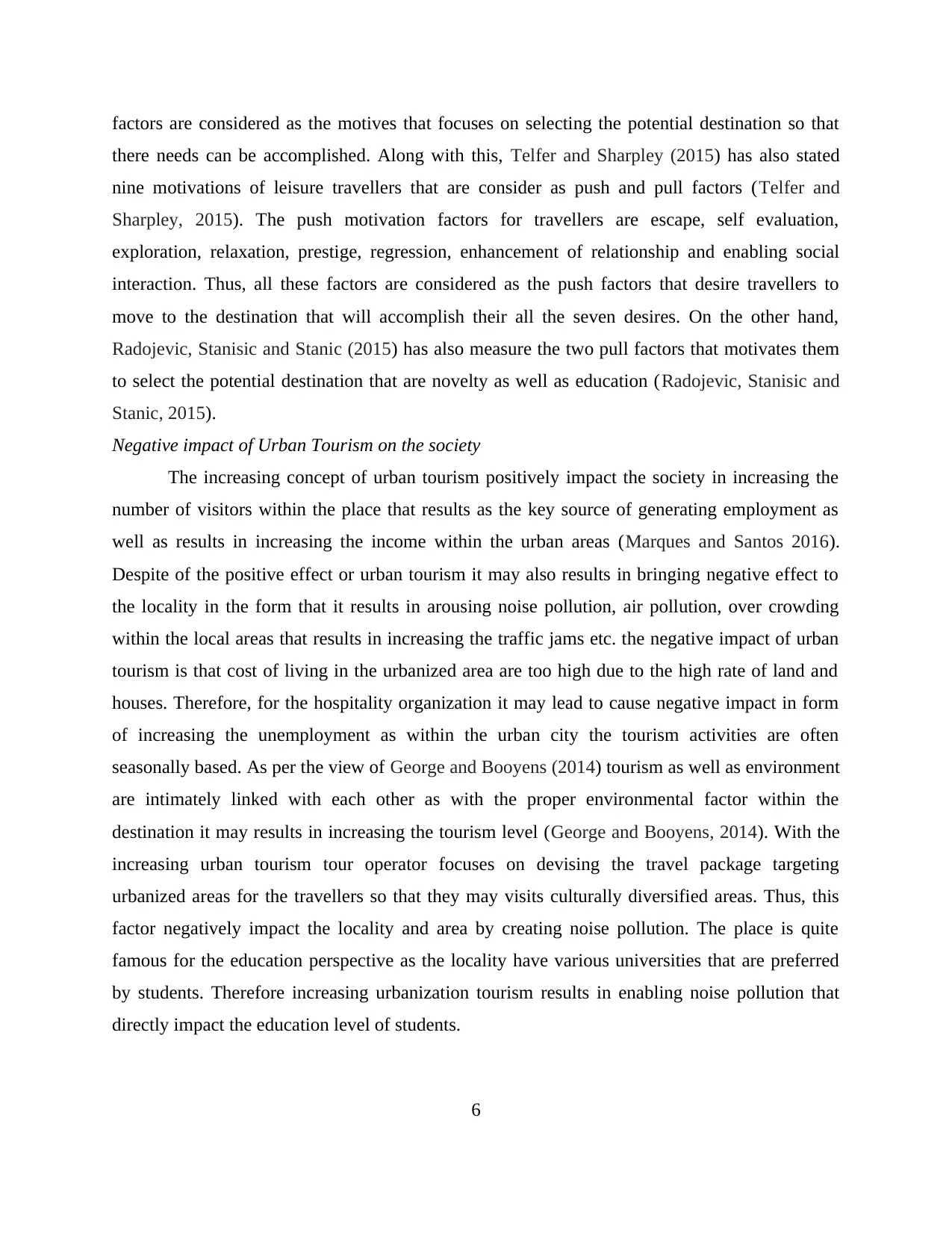
factors are considered as the motives that focuses on selecting the potential destination so that
there needs can be accomplished. Along with this, Telfer and Sharpley (2015) has also stated
nine motivations of leisure travellers that are consider as push and pull factors (Telfer and
Sharpley, 2015). The push motivation factors for travellers are escape, self evaluation,
exploration, relaxation, prestige, regression, enhancement of relationship and enabling social
interaction. Thus, all these factors are considered as the push factors that desire travellers to
move to the destination that will accomplish their all the seven desires. On the other hand,
Radojevic, Stanisic and Stanic (2015) has also measure the two pull factors that motivates them
to select the potential destination that are novelty as well as education (Radojevic, Stanisic and
Stanic, 2015).
Negative impact of Urban Tourism on the society
The increasing concept of urban tourism positively impact the society in increasing the
number of visitors within the place that results as the key source of generating employment as
well as results in increasing the income within the urban areas (Marques and Santos 2016).
Despite of the positive effect or urban tourism it may also results in bringing negative effect to
the locality in the form that it results in arousing noise pollution, air pollution, over crowding
within the local areas that results in increasing the traffic jams etc. the negative impact of urban
tourism is that cost of living in the urbanized area are too high due to the high rate of land and
houses. Therefore, for the hospitality organization it may lead to cause negative impact in form
of increasing the unemployment as within the urban city the tourism activities are often
seasonally based. As per the view of George and Booyens (2014) tourism as well as environment
are intimately linked with each other as with the proper environmental factor within the
destination it may results in increasing the tourism level (George and Booyens, 2014). With the
increasing urban tourism tour operator focuses on devising the travel package targeting
urbanized areas for the travellers so that they may visits culturally diversified areas. Thus, this
factor negatively impact the locality and area by creating noise pollution. The place is quite
famous for the education perspective as the locality have various universities that are preferred
by students. Therefore increasing urbanization tourism results in enabling noise pollution that
directly impact the education level of students.
6
there needs can be accomplished. Along with this, Telfer and Sharpley (2015) has also stated
nine motivations of leisure travellers that are consider as push and pull factors (Telfer and
Sharpley, 2015). The push motivation factors for travellers are escape, self evaluation,
exploration, relaxation, prestige, regression, enhancement of relationship and enabling social
interaction. Thus, all these factors are considered as the push factors that desire travellers to
move to the destination that will accomplish their all the seven desires. On the other hand,
Radojevic, Stanisic and Stanic (2015) has also measure the two pull factors that motivates them
to select the potential destination that are novelty as well as education (Radojevic, Stanisic and
Stanic, 2015).
Negative impact of Urban Tourism on the society
The increasing concept of urban tourism positively impact the society in increasing the
number of visitors within the place that results as the key source of generating employment as
well as results in increasing the income within the urban areas (Marques and Santos 2016).
Despite of the positive effect or urban tourism it may also results in bringing negative effect to
the locality in the form that it results in arousing noise pollution, air pollution, over crowding
within the local areas that results in increasing the traffic jams etc. the negative impact of urban
tourism is that cost of living in the urbanized area are too high due to the high rate of land and
houses. Therefore, for the hospitality organization it may lead to cause negative impact in form
of increasing the unemployment as within the urban city the tourism activities are often
seasonally based. As per the view of George and Booyens (2014) tourism as well as environment
are intimately linked with each other as with the proper environmental factor within the
destination it may results in increasing the tourism level (George and Booyens, 2014). With the
increasing urban tourism tour operator focuses on devising the travel package targeting
urbanized areas for the travellers so that they may visits culturally diversified areas. Thus, this
factor negatively impact the locality and area by creating noise pollution. The place is quite
famous for the education perspective as the locality have various universities that are preferred
by students. Therefore increasing urbanization tourism results in enabling noise pollution that
directly impact the education level of students.
6
⊘ This is a preview!⊘
Do you want full access?
Subscribe today to unlock all pages.

Trusted by 1+ million students worldwide
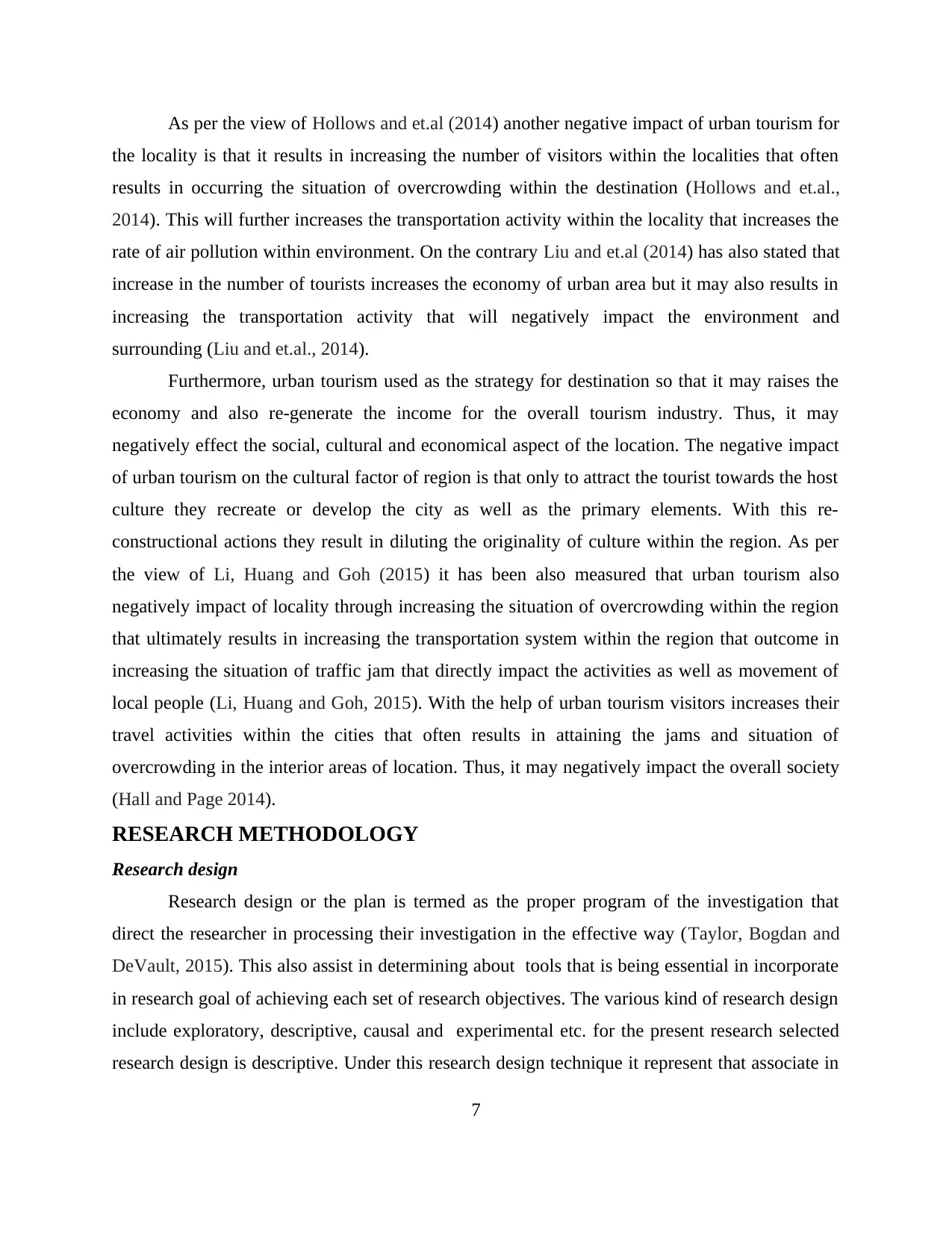
As per the view of Hollows and et.al (2014) another negative impact of urban tourism for
the locality is that it results in increasing the number of visitors within the localities that often
results in occurring the situation of overcrowding within the destination (Hollows and et.al.,
2014). This will further increases the transportation activity within the locality that increases the
rate of air pollution within environment. On the contrary Liu and et.al (2014) has also stated that
increase in the number of tourists increases the economy of urban area but it may also results in
increasing the transportation activity that will negatively impact the environment and
surrounding (Liu and et.al., 2014).
Furthermore, urban tourism used as the strategy for destination so that it may raises the
economy and also re-generate the income for the overall tourism industry. Thus, it may
negatively effect the social, cultural and economical aspect of the location. The negative impact
of urban tourism on the cultural factor of region is that only to attract the tourist towards the host
culture they recreate or develop the city as well as the primary elements. With this re-
constructional actions they result in diluting the originality of culture within the region. As per
the view of Li, Huang and Goh (2015) it has been also measured that urban tourism also
negatively impact of locality through increasing the situation of overcrowding within the region
that ultimately results in increasing the transportation system within the region that outcome in
increasing the situation of traffic jam that directly impact the activities as well as movement of
local people (Li, Huang and Goh, 2015). With the help of urban tourism visitors increases their
travel activities within the cities that often results in attaining the jams and situation of
overcrowding in the interior areas of location. Thus, it may negatively impact the overall society
(Hall and Page 2014).
RESEARCH METHODOLOGY
Research design
Research design or the plan is termed as the proper program of the investigation that
direct the researcher in processing their investigation in the effective way (Taylor, Bogdan and
DeVault, 2015). This also assist in determining about tools that is being essential in incorporate
in research goal of achieving each set of research objectives. The various kind of research design
include exploratory, descriptive, causal and experimental etc. for the present research selected
research design is descriptive. Under this research design technique it represent that associate in
7
the locality is that it results in increasing the number of visitors within the localities that often
results in occurring the situation of overcrowding within the destination (Hollows and et.al.,
2014). This will further increases the transportation activity within the locality that increases the
rate of air pollution within environment. On the contrary Liu and et.al (2014) has also stated that
increase in the number of tourists increases the economy of urban area but it may also results in
increasing the transportation activity that will negatively impact the environment and
surrounding (Liu and et.al., 2014).
Furthermore, urban tourism used as the strategy for destination so that it may raises the
economy and also re-generate the income for the overall tourism industry. Thus, it may
negatively effect the social, cultural and economical aspect of the location. The negative impact
of urban tourism on the cultural factor of region is that only to attract the tourist towards the host
culture they recreate or develop the city as well as the primary elements. With this re-
constructional actions they result in diluting the originality of culture within the region. As per
the view of Li, Huang and Goh (2015) it has been also measured that urban tourism also
negatively impact of locality through increasing the situation of overcrowding within the region
that ultimately results in increasing the transportation system within the region that outcome in
increasing the situation of traffic jam that directly impact the activities as well as movement of
local people (Li, Huang and Goh, 2015). With the help of urban tourism visitors increases their
travel activities within the cities that often results in attaining the jams and situation of
overcrowding in the interior areas of location. Thus, it may negatively impact the overall society
(Hall and Page 2014).
RESEARCH METHODOLOGY
Research design
Research design or the plan is termed as the proper program of the investigation that
direct the researcher in processing their investigation in the effective way (Taylor, Bogdan and
DeVault, 2015). This also assist in determining about tools that is being essential in incorporate
in research goal of achieving each set of research objectives. The various kind of research design
include exploratory, descriptive, causal and experimental etc. for the present research selected
research design is descriptive. Under this research design technique it represent that associate in
7
Paraphrase This Document
Need a fresh take? Get an instant paraphrase of this document with our AI Paraphraser
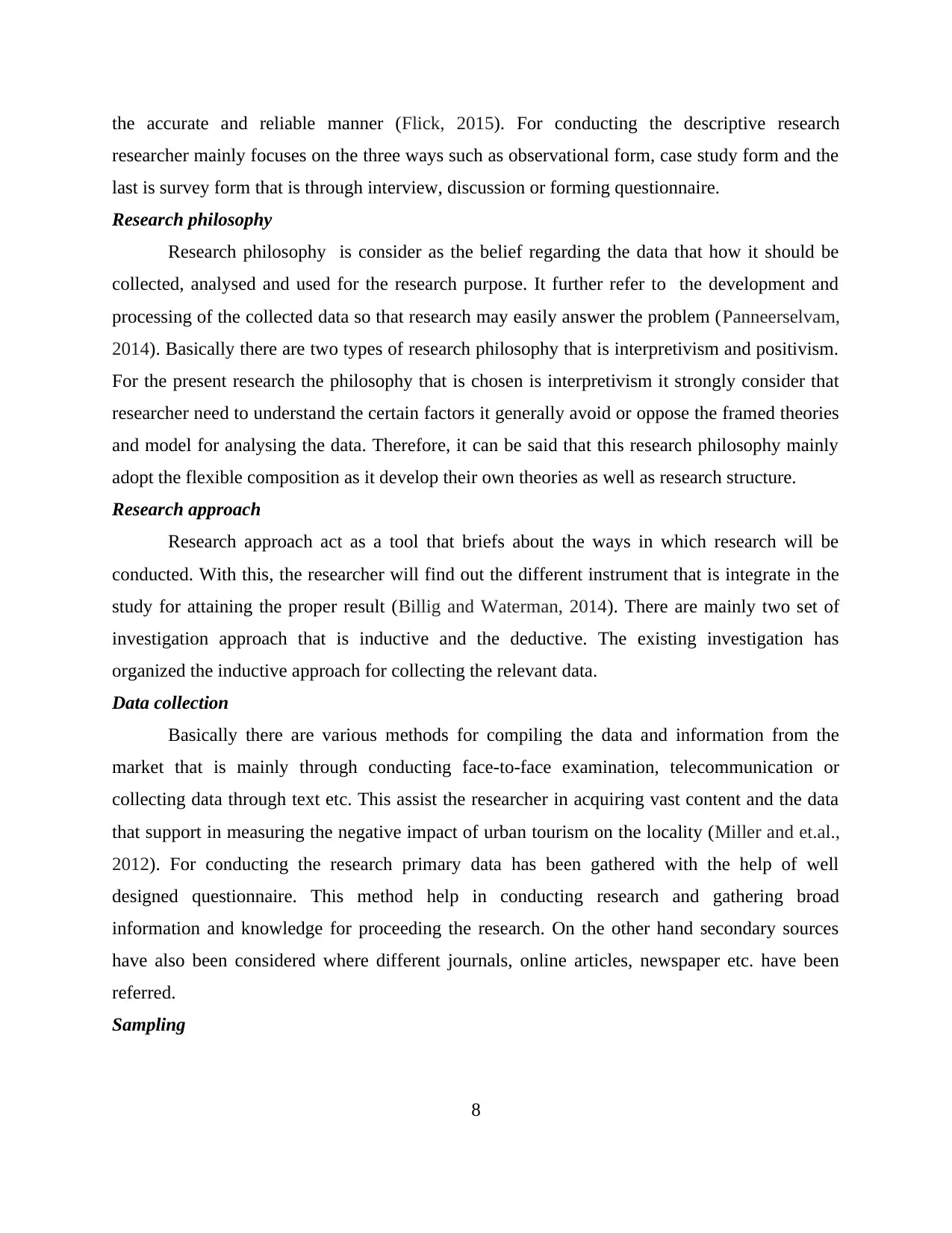
the accurate and reliable manner (Flick, 2015). For conducting the descriptive research
researcher mainly focuses on the three ways such as observational form, case study form and the
last is survey form that is through interview, discussion or forming questionnaire.
Research philosophy
Research philosophy is consider as the belief regarding the data that how it should be
collected, analysed and used for the research purpose. It further refer to the development and
processing of the collected data so that research may easily answer the problem (Panneerselvam,
2014). Basically there are two types of research philosophy that is interpretivism and positivism.
For the present research the philosophy that is chosen is interpretivism it strongly consider that
researcher need to understand the certain factors it generally avoid or oppose the framed theories
and model for analysing the data. Therefore, it can be said that this research philosophy mainly
adopt the flexible composition as it develop their own theories as well as research structure.
Research approach
Research approach act as a tool that briefs about the ways in which research will be
conducted. With this, the researcher will find out the different instrument that is integrate in the
study for attaining the proper result (Billig and Waterman, 2014). There are mainly two set of
investigation approach that is inductive and the deductive. The existing investigation has
organized the inductive approach for collecting the relevant data.
Data collection
Basically there are various methods for compiling the data and information from the
market that is mainly through conducting face-to-face examination, telecommunication or
collecting data through text etc. This assist the researcher in acquiring vast content and the data
that support in measuring the negative impact of urban tourism on the locality (Miller and et.al.,
2012). For conducting the research primary data has been gathered with the help of well
designed questionnaire. This method help in conducting research and gathering broad
information and knowledge for proceeding the research. On the other hand secondary sources
have also been considered where different journals, online articles, newspaper etc. have been
referred.
Sampling
8
researcher mainly focuses on the three ways such as observational form, case study form and the
last is survey form that is through interview, discussion or forming questionnaire.
Research philosophy
Research philosophy is consider as the belief regarding the data that how it should be
collected, analysed and used for the research purpose. It further refer to the development and
processing of the collected data so that research may easily answer the problem (Panneerselvam,
2014). Basically there are two types of research philosophy that is interpretivism and positivism.
For the present research the philosophy that is chosen is interpretivism it strongly consider that
researcher need to understand the certain factors it generally avoid or oppose the framed theories
and model for analysing the data. Therefore, it can be said that this research philosophy mainly
adopt the flexible composition as it develop their own theories as well as research structure.
Research approach
Research approach act as a tool that briefs about the ways in which research will be
conducted. With this, the researcher will find out the different instrument that is integrate in the
study for attaining the proper result (Billig and Waterman, 2014). There are mainly two set of
investigation approach that is inductive and the deductive. The existing investigation has
organized the inductive approach for collecting the relevant data.
Data collection
Basically there are various methods for compiling the data and information from the
market that is mainly through conducting face-to-face examination, telecommunication or
collecting data through text etc. This assist the researcher in acquiring vast content and the data
that support in measuring the negative impact of urban tourism on the locality (Miller and et.al.,
2012). For conducting the research primary data has been gathered with the help of well
designed questionnaire. This method help in conducting research and gathering broad
information and knowledge for proceeding the research. On the other hand secondary sources
have also been considered where different journals, online articles, newspaper etc. have been
referred.
Sampling
8
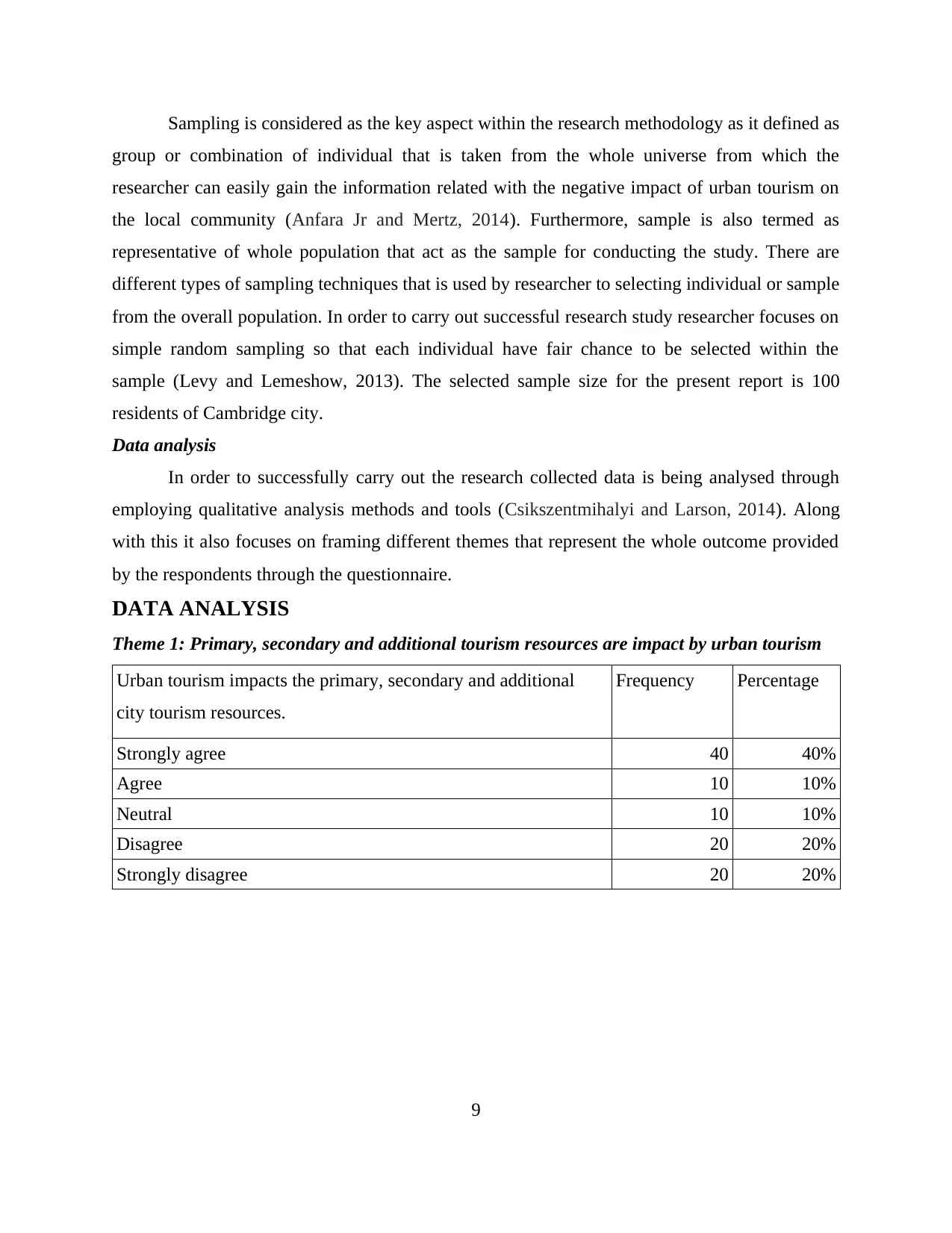
Sampling is considered as the key aspect within the research methodology as it defined as
group or combination of individual that is taken from the whole universe from which the
researcher can easily gain the information related with the negative impact of urban tourism on
the local community (Anfara Jr and Mertz, 2014). Furthermore, sample is also termed as
representative of whole population that act as the sample for conducting the study. There are
different types of sampling techniques that is used by researcher to selecting individual or sample
from the overall population. In order to carry out successful research study researcher focuses on
simple random sampling so that each individual have fair chance to be selected within the
sample (Levy and Lemeshow, 2013). The selected sample size for the present report is 100
residents of Cambridge city.
Data analysis
In order to successfully carry out the research collected data is being analysed through
employing qualitative analysis methods and tools (Csikszentmihalyi and Larson, 2014). Along
with this it also focuses on framing different themes that represent the whole outcome provided
by the respondents through the questionnaire.
DATA ANALYSIS
Theme 1: Primary, secondary and additional tourism resources are impact by urban tourism
Urban tourism impacts the primary, secondary and additional
city tourism resources.
Frequency Percentage
Strongly agree 40 40%
Agree 10 10%
Neutral 10 10%
Disagree 20 20%
Strongly disagree 20 20%
9
group or combination of individual that is taken from the whole universe from which the
researcher can easily gain the information related with the negative impact of urban tourism on
the local community (Anfara Jr and Mertz, 2014). Furthermore, sample is also termed as
representative of whole population that act as the sample for conducting the study. There are
different types of sampling techniques that is used by researcher to selecting individual or sample
from the overall population. In order to carry out successful research study researcher focuses on
simple random sampling so that each individual have fair chance to be selected within the
sample (Levy and Lemeshow, 2013). The selected sample size for the present report is 100
residents of Cambridge city.
Data analysis
In order to successfully carry out the research collected data is being analysed through
employing qualitative analysis methods and tools (Csikszentmihalyi and Larson, 2014). Along
with this it also focuses on framing different themes that represent the whole outcome provided
by the respondents through the questionnaire.
DATA ANALYSIS
Theme 1: Primary, secondary and additional tourism resources are impact by urban tourism
Urban tourism impacts the primary, secondary and additional
city tourism resources.
Frequency Percentage
Strongly agree 40 40%
Agree 10 10%
Neutral 10 10%
Disagree 20 20%
Strongly disagree 20 20%
9
⊘ This is a preview!⊘
Do you want full access?
Subscribe today to unlock all pages.

Trusted by 1+ million students worldwide
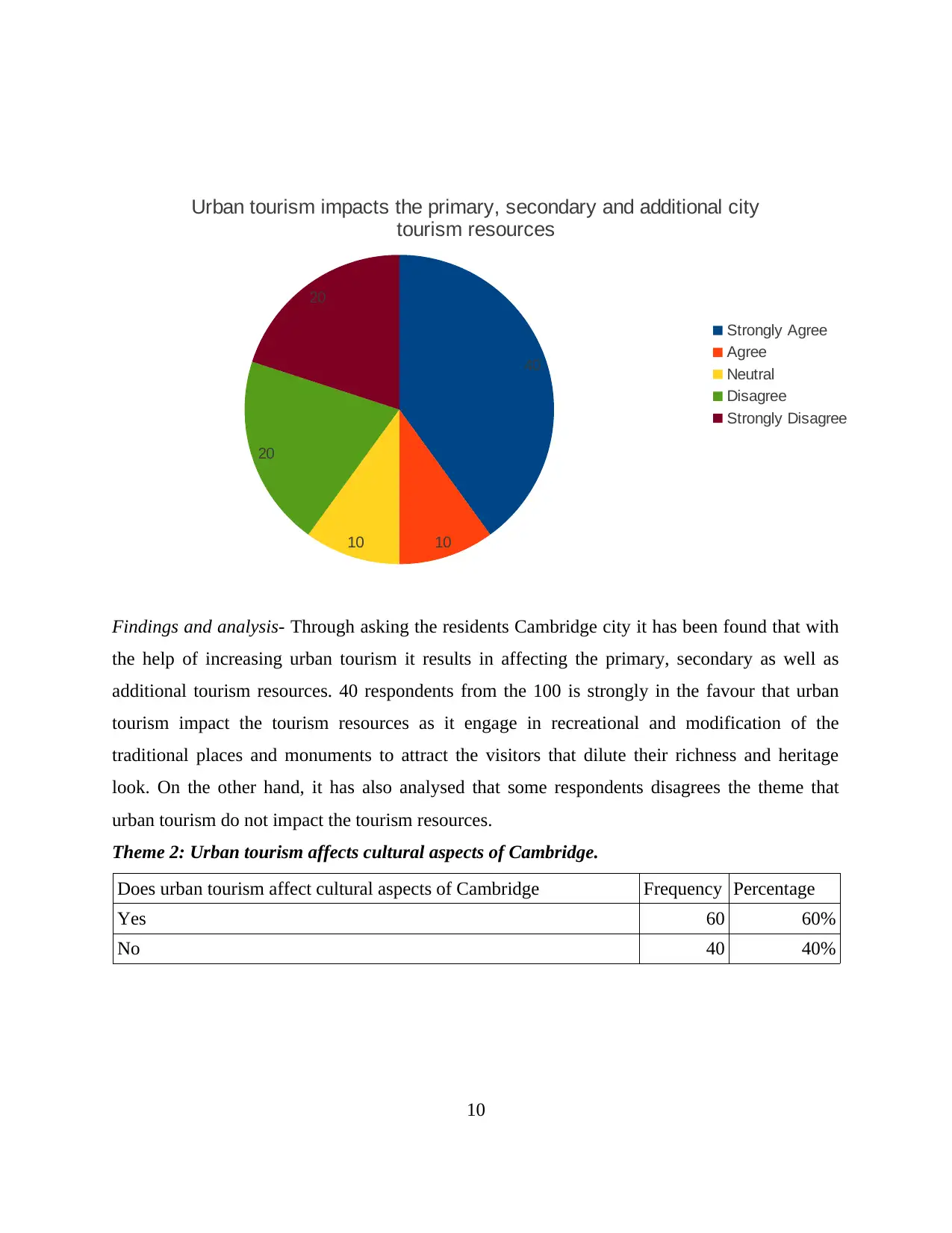
Findings and analysis- Through asking the residents Cambridge city it has been found that with
the help of increasing urban tourism it results in affecting the primary, secondary as well as
additional tourism resources. 40 respondents from the 100 is strongly in the favour that urban
tourism impact the tourism resources as it engage in recreational and modification of the
traditional places and monuments to attract the visitors that dilute their richness and heritage
look. On the other hand, it has also analysed that some respondents disagrees the theme that
urban tourism do not impact the tourism resources.
Theme 2: Urban tourism affects cultural aspects of Cambridge.
Does urban tourism affect cultural aspects of Cambridge Frequency Percentage
Yes 60 60%
No 40 40%
10
40
1010
20
20
Urban tourism impacts the primary, secondary and additional city
tourism resources
Strongly Agree
Agree
Neutral
Disagree
Strongly Disagree
the help of increasing urban tourism it results in affecting the primary, secondary as well as
additional tourism resources. 40 respondents from the 100 is strongly in the favour that urban
tourism impact the tourism resources as it engage in recreational and modification of the
traditional places and monuments to attract the visitors that dilute their richness and heritage
look. On the other hand, it has also analysed that some respondents disagrees the theme that
urban tourism do not impact the tourism resources.
Theme 2: Urban tourism affects cultural aspects of Cambridge.
Does urban tourism affect cultural aspects of Cambridge Frequency Percentage
Yes 60 60%
No 40 40%
10
40
1010
20
20
Urban tourism impacts the primary, secondary and additional city
tourism resources
Strongly Agree
Agree
Neutral
Disagree
Strongly Disagree
Paraphrase This Document
Need a fresh take? Get an instant paraphrase of this document with our AI Paraphraser
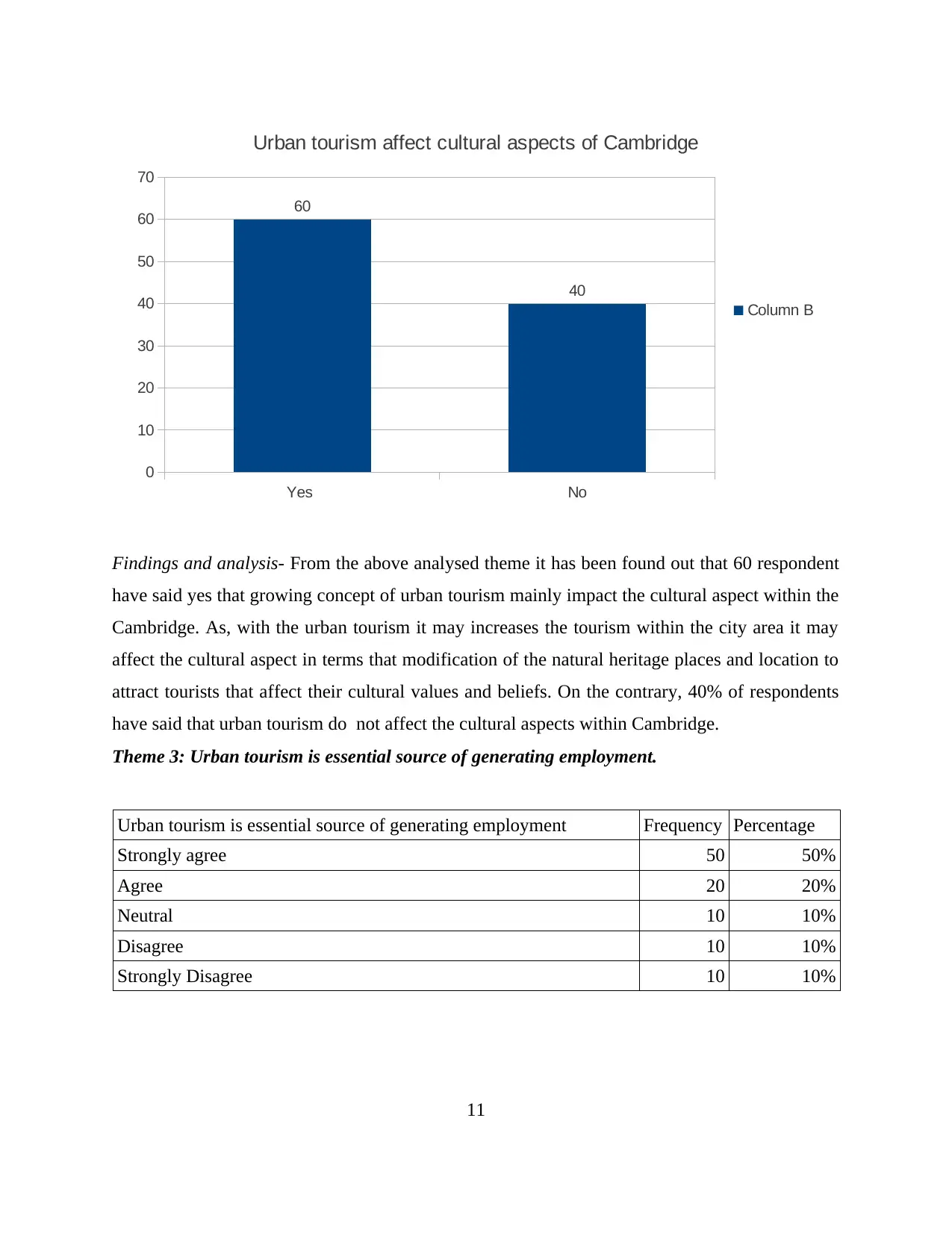
Findings and analysis- From the above analysed theme it has been found out that 60 respondent
have said yes that growing concept of urban tourism mainly impact the cultural aspect within the
Cambridge. As, with the urban tourism it may increases the tourism within the city area it may
affect the cultural aspect in terms that modification of the natural heritage places and location to
attract tourists that affect their cultural values and beliefs. On the contrary, 40% of respondents
have said that urban tourism do not affect the cultural aspects within Cambridge.
Theme 3: Urban tourism is essential source of generating employment.
Urban tourism is essential source of generating employment Frequency Percentage
Strongly agree 50 50%
Agree 20 20%
Neutral 10 10%
Disagree 10 10%
Strongly Disagree 10 10%
11
Yes No
0
10
20
30
40
50
60
70
60
40
Urban tourism affect cultural aspects of Cambridge
Column B
have said yes that growing concept of urban tourism mainly impact the cultural aspect within the
Cambridge. As, with the urban tourism it may increases the tourism within the city area it may
affect the cultural aspect in terms that modification of the natural heritage places and location to
attract tourists that affect their cultural values and beliefs. On the contrary, 40% of respondents
have said that urban tourism do not affect the cultural aspects within Cambridge.
Theme 3: Urban tourism is essential source of generating employment.
Urban tourism is essential source of generating employment Frequency Percentage
Strongly agree 50 50%
Agree 20 20%
Neutral 10 10%
Disagree 10 10%
Strongly Disagree 10 10%
11
Yes No
0
10
20
30
40
50
60
70
60
40
Urban tourism affect cultural aspects of Cambridge
Column B
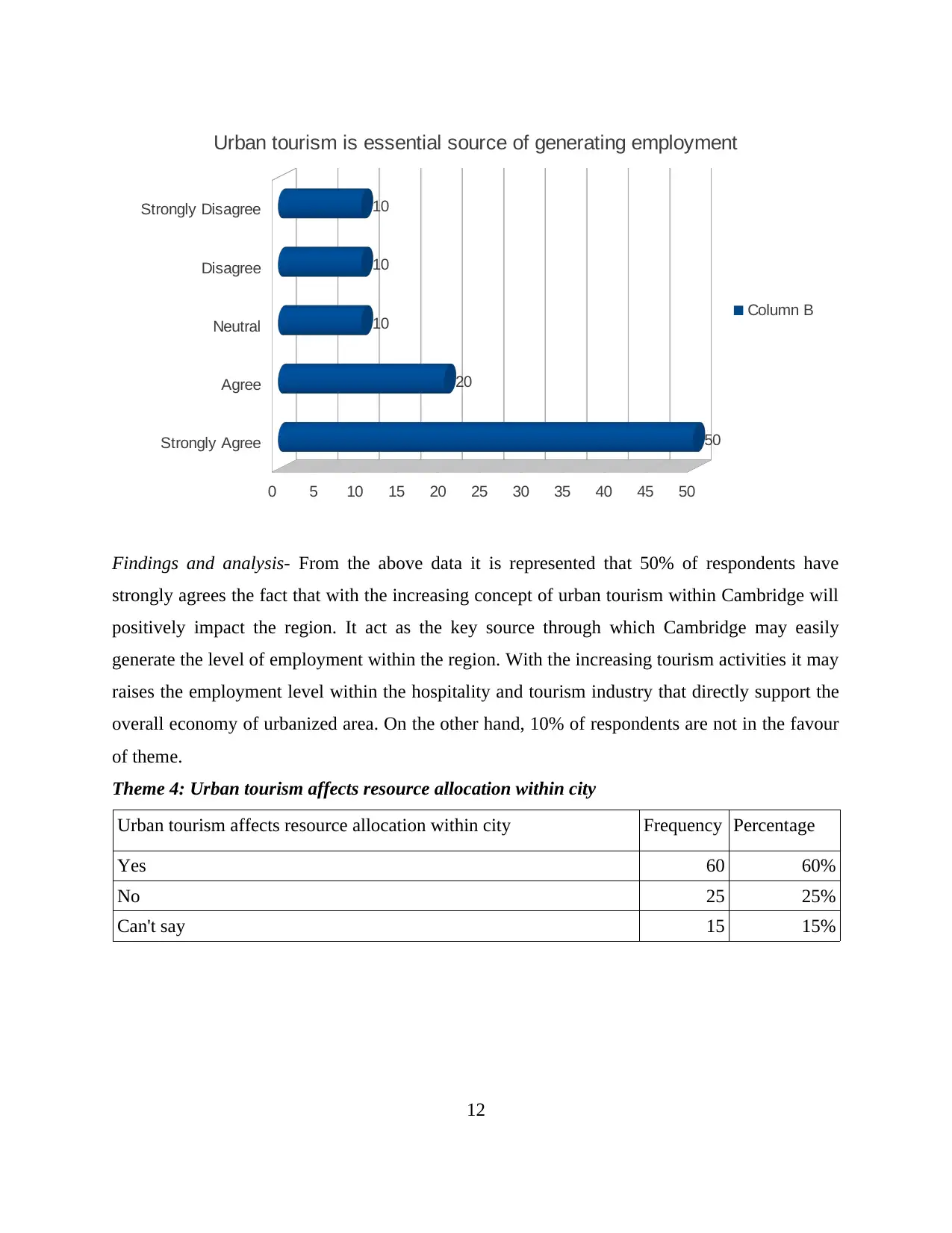
Findings and analysis- From the above data it is represented that 50% of respondents have
strongly agrees the fact that with the increasing concept of urban tourism within Cambridge will
positively impact the region. It act as the key source through which Cambridge may easily
generate the level of employment within the region. With the increasing tourism activities it may
raises the employment level within the hospitality and tourism industry that directly support the
overall economy of urbanized area. On the other hand, 10% of respondents are not in the favour
of theme.
Theme 4: Urban tourism affects resource allocation within city
Urban tourism affects resource allocation within city Frequency Percentage
Yes 60 60%
No 25 25%
Can't say 15 15%
12
Strongly Agree
Agree
Neutral
Disagree
Strongly Disagree
0 5 10 15 20 25 30 35 40 45 50
50
20
10
10
10
Urban tourism is essential source of generating employment
Column B
strongly agrees the fact that with the increasing concept of urban tourism within Cambridge will
positively impact the region. It act as the key source through which Cambridge may easily
generate the level of employment within the region. With the increasing tourism activities it may
raises the employment level within the hospitality and tourism industry that directly support the
overall economy of urbanized area. On the other hand, 10% of respondents are not in the favour
of theme.
Theme 4: Urban tourism affects resource allocation within city
Urban tourism affects resource allocation within city Frequency Percentage
Yes 60 60%
No 25 25%
Can't say 15 15%
12
Strongly Agree
Agree
Neutral
Disagree
Strongly Disagree
0 5 10 15 20 25 30 35 40 45 50
50
20
10
10
10
Urban tourism is essential source of generating employment
Column B
⊘ This is a preview!⊘
Do you want full access?
Subscribe today to unlock all pages.

Trusted by 1+ million students worldwide
1 out of 22
Related Documents
Your All-in-One AI-Powered Toolkit for Academic Success.
+13062052269
info@desklib.com
Available 24*7 on WhatsApp / Email
![[object Object]](/_next/static/media/star-bottom.7253800d.svg)
Unlock your academic potential
Copyright © 2020–2025 A2Z Services. All Rights Reserved. Developed and managed by ZUCOL.





